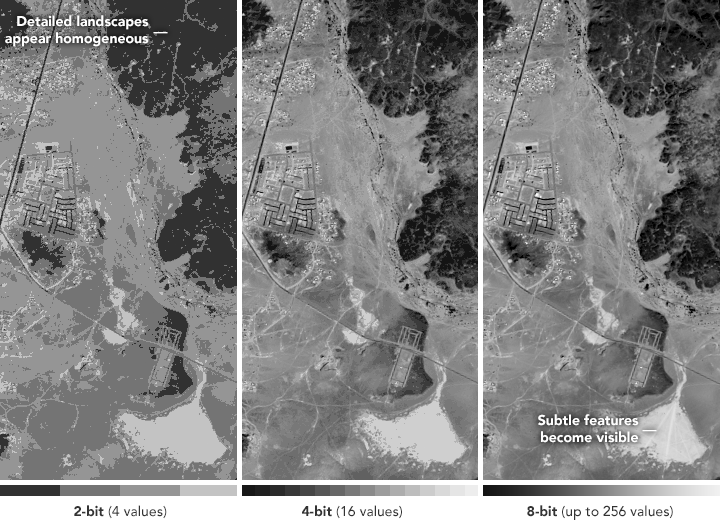Remark
Please be aware that these lecture notes are accessible online in an ‘early access’ format. They are actively being developed, and certain sections will be further enriched to provide a comprehensive understanding of the subject matter.
1.3. Radiometric Resolution#
Radiometric resolution describes a sensor’s ability to distinguish fine gradations in energy levels, which are manifested as differences in image brightness. This is comparable to the human eye’s capacity to perceive subtle variations in color shades [Sabins and Ellis, 2020].
Radiometric resolution quantifies the detail within each pixel, defined by the number of bits encoding the energy measured. Each bit corresponds to an exponent of 2, meaning that an 8-bit resolution can represent \(2^8\) or 256 distinct digital values, ranging from 0 to 255. Therefore, sensors with a higher radiometric resolution have a broader range of values to encode information, allowing for more precise differentiation of even minor energy variations. For instance, in water quality analysis, high radiometric resolution is crucial for identifying slight changes in ocean hues [Earth Science Data Systems, 2019].

Fig. 1.5 High radiometric resolution sensors are capable of detecting finer nuances and a broader range of light intensity. Credit: NASA Earth Observatory images by Joshua Stevens, using Landsat data from the U.S. Geological Survey. Link to Image.#
Fig. 1.5 illustrates the concept of radiometric resolution in sensors, which refers to their ability to detect and measure the intensity of light:
1.3.1. Understanding Radiometric Resolution through Bit Depth#
Radiometric resolution is crucial for capturing the intricacies of the Earth’s surface. As the bit depth increases, the sensor can distinguish more levels of light intensity, resulting in greater detail in the captured image. This is essential for applications that require detailed Earth observation and precise mapping, where distinguishing subtle differences is necessary.
1.3.2. Bit Depth and Digital Values#
Fig. 1.6 was captured in the Wuchang district of Wuhan, China using an iPhone 15 Pro Max. The image resolution was then reduced to 1000 × 750 for web viewing.

Fig. 1.6 An image of Wuhan at 24-bit resolution. The highest commonly used resolution, capable of displaying over 16 million colors and capturing fine details. Note: Image taken and processed by H. Dastour.#
To illustrate different bit depths, the bit resolution of the image above was modified to 1, 2, 4, and 8 bits using the OpenCV API in Python.
1-bit Resolution: An image with only 1-bit resolution can represent 2 values (0 and 1). This extremely low resolution results in a very homogenous image with minimal detail, making it difficult to discern any variations in the captured scene.

Fig. 1.7 An image of Wuhan at 1-bit resolution. The image appears very homogenous, lacking detail. Note: Image taken and processed by H. Dastour.#
2-bit Resolution: An image with 2-bit resolution can represent 4 values (0-3). This still low resolution provides a slightly better representation than 1-bit but remains very homogenous, with limited detail and few variations visible.

Fig. 1.8 An image of Wuhan at 2-bit resolution. The image appears very homogenous, lacking detail. Note: Image taken and processed by H. Dastour.#
4-bit Resolution: An image with 4-bit resolution can represent 16 values (0-15). This intermediate resolution allows for more variation and some detail, making it possible to discern more features and differences in the image.

Fig. 1.9 An image of Wuhan at 4-bit resolution. This resolution allows for more variation and some detail. Note: Image taken and processed by H. Dastour.#
8-bit Resolution: An image with 8-bit resolution can represent 256 values (0-255). This higher resolution allows for subtle features to become visible, capturing fine details and variations in energy levels.

Fig. 1.10 An image of Wuhan at 8-bit resolution. The highest resolution shown, with up to 256 values, where subtle features become visible. Note: Image taken and processed by H. Dastour.#
1.3.3. Technical Quantification of Radiometric Resolution#
Radiometric resolution is quantified in bits, with the bit depth representing the energy levels a sensor can record. For example:
An 8-bit sensor captures \(2^8\) or 256 energy levels.
A 16-bit sensor captures \(2^{16}\) or 65,536 energy levels.
This bit depth means each pixel can display a range of brightness levels, enhancing the image’s detail. The formula for intensity levels is:
where \(n\) is the number of bits.
Example 1.1
For instance, consider a satellite sensor with a 12-bit radiometric resolution. This sensor can capture \(2^{12}\) or 4,096 different intensity levels. This high bit depth allows for more detailed and nuanced images, which is particularly useful in applications requiring precise measurements, such as vegetation health monitoring or urban planning.
Table 1.1 summarizes the relationship between common bit depths and their corresponding intensity levels:
Bit Depth |
Intensity Levels |
Value Range |
|---|---|---|
1 |
2 |
0-1 |
2 |
4 |
0-3 |
3 |
8 |
0-7 |
4 |
16 |
0-15 |
6 |
64 |
0-63 |
8 |
256 |
0-255 |
10 |
1024 |
0-1023 |
12 |
4096 |
0-4095 |
16 |
65536 |
0-65535 |
This table illustrates how increasing the bit depth enhances the sensor’s ability to capture finer details in the image.
1.3.4. Importance of High Radiometric Resolution#
Higher radiometric resolution means greater sensor sensitivity to energy differences, crucial for analyzing features with low contrast but significant differences in other wavelengths. This sensitivity is vital for applications that rely on detecting and measuring subtle variations in energy levels:
Agriculture: High radiometric resolution allows for assessing crop health, soil moisture, and detecting early signs of stress or disease. It enables precision agriculture, where accurate data is essential for optimizing inputs and improving yields [Rao et al., 2006, Segarra, 2024].
Environmental Monitoring: Evaluating vegetation health, tracking deforestation, and monitoring ecosystem changes require capturing subtle variations in reflectance. High radiometric resolution sensors provide the detail needed for effective environmental management [Cao et al., 2014].
Geological Studies: Identifying mineral and rock types involves distinguishing slight differences in spectral signatures. High radiometric resolution enhances the accuracy of geological mapping and resource exploration [Kamel et al., 2022].
Urban Planning: Mapping land use, infrastructure, and changes in urban environments necessitates capturing fine details. High radiometric resolution supports accurate urban planning and development [Huang et al., 2022, Li et al., 2020].
